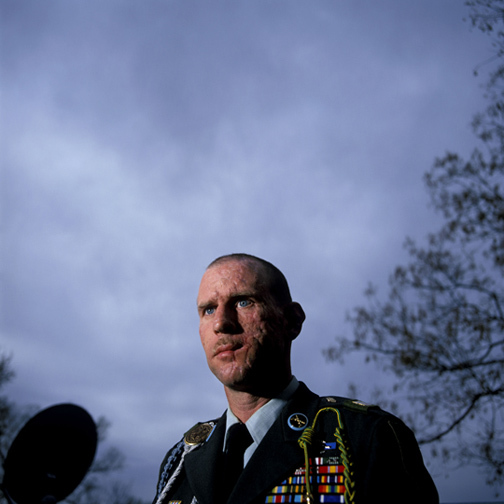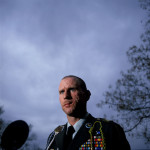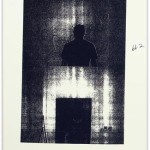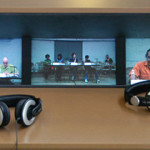By MATTHEW NASH
This book is to be neither an accusation nor a confession, and least of all an adventure, for death is not an adventure to those who stand face to face with it. It will try simply to tell of a generation of men who, even though they may have escaped its shells, were destroyed by the war.Erich Maria Remarque
introduction to "All Quiet On The Western Front"
How do we tell the story of war? Do we tell stories of glory and valor, or do we talk about the gore, the humiliation, the violence? What is the meaning of life surrounded by meaningless, ever-present death? What can those who have seen war convey of its horrors to those who have never witnessed it?
"War Stories" at MassArt is an intensive, moving, and delicately considered exploration of the war in Iraq. Deftly curated by Lisa Tung, this exhibition manages to engage the viewer in an immediate relationship with the participants, while also offering a deep and thorough exploration of the many facets of war. Make no mistake about it, this is a show that requires an investment of time and emotion, yet it is completely worth it.
At no point does "War Stories" attempt to make a decisive anti-war statement; neither does it declare a pro-war stance. Instead, the three bodies of work offer a mixed collection of conflicting perspectives, each complex and requiring detailed exploration in order to form an opinion. There are no conclusions offered, only stories, and every voice tells a tale that is far more intricate than the narratives repeated on the evening news. Viewers who come to this show with anti-war views will have their ideas reenforced, and yet will also be presented with stories that shed light on why others might choose to fight. Those with pro-war views will similarly find their ideas echoed, yet it is hard to face the consequences of war without asking tough questions.
The three bodies of work in "War Stories" are incredibly diverse in their source material, presentation and goals, yet within the Bakalar Gallery they complement each other well. Upon entering, Jenny Holzer's Redaction Paintings confront viewers with the memos that circulated through our government in the runup to the war. These documents are printed on medium-sized canvases, sometimes over red or yellow, and make a pretense of being art while also acting as photocopied reproductions of government memos. Devoting time to theRedaction Paintings is hard to do, as they are mostly the corporate jargon of government, yet hidden under the sterile vernacular is the case for war made by our leaders. It's difficult to read through these texts and make heads or tails of how this clean, sterile and inhuman language could lead to the brutal and violent act of war; there is so little humanity present in the memos that they might as well be ordering a new photocioper.
Nina Berman's photographic series Purple Hearts brings the effects of the war directly into the gallery, and puts viewers face to face with soldiers who have suffered horribly as a result of combat. In perhaps the most touching image, a disfigured Marine stands beside his bride on their wedding day. The Marine's face has been burned and scarred, he has no ear, and yet he looks lovingly at his bride, who has an expression that appears as both surprised and horrified.
Each of Berman's images (other than the wedding image) are accompanied by a small block of text, telling the story of the subject. While one might expect a strong anti-war message from those that have witnessed it firsthand, instead there is a conflicted and often pro-military narrative. Many of the soldiers claim to miss the military and the structure it brought to their life. Others have re-enlisted, despite their injuries, while many declare their hatred of the conflict in Iraq and cast blame on the government that took them into the war. There is no consistent thread running through the stories, and that is perhaps the most powerful part of the work. Each soldier seems to both support their peers and dislike the war, or dislike the way the war is conducted. For some this is very strongly expressed, for others it is merely a confusion, or a disconnect that they cannot find the words to express.
Berman's images also come paired with a series of audio interviews with her subjects. These are presented in a small side room, where one can sit on a bench and hear the voices of soldiers discussing their war experiences. While they are powerful, these seemed to be a little bit diminished by the long running time and lack of editing in some of the narratives. Where the text beside the photographs cut right to the heart of the soldier's story, indecision and confusion intact, the audio requires more time and, in the context of an exhibition with several hours of video, is hard to experience for any duration.
The final body of work in "War Stories" is 9 Scripts from a Nation at War by David Thorne, Katya Sander, Ashley Hunt, Sharon Hayes, and Andrea Geyer. This series of 10 video pieces explores the diverse human experiences of war, and was first presented at Documenta 12. Each presents an actor or group of actors performing a script based on interviews with those who have seen the war up close, or transcripts of actual events. These various views come from students, bloggers, citizens, journalists, and other witnesses.
In one multi-screen piece, a group of actors read from transcripts of war tribunals at Guantanamo, while others look on. Three actors play the tribunal, three play the lawyers and detainee representatives, and one plays the detainee. While trial footage of a military tribunal would be difficult to watch, the presence of actors in a constructed scenario allows for some access and understanding of the events unfolding. Over the course of the 20-minute video, the trials become transparently absurd, and the nature of the questions are revealed to be masking deeper (and more sinister?) objectives. Even as the actors fumble to read their lines, the viewer is brought into a courtroom they will never see, faced with a tribunal that is not concerned with truth, and a court process that is clearly a mockery.
Of the 10 videos in 9 Scripts from a Nation at War, the story presented by the Iraqi blogger is the most compelling. Some of this may be due to the subtlety and skill with which the actor reads each blog post, but mostly it is the content and quality of the blog posts themselves that are so engaging. The actor looks to the camera and reads from a piece of paper, pauses then turns the sheet over. Each sheet is a short blog post, and while one might expect them to be full of stories of war, bombs, and death, they are instead deeply personal explorations of life, humanity, and family. The narrative, such as it is, comes from a person who is faced daily with death and thus confronts life, and looks to make the best of it.
"War Stories" is an exhibition that requires a committment of time, thought, and emotion. It is not an easy show, nor does it provide easy answers. Yet, like Erich Remarque and many like him, it tells the story of war through the eyes of those who have seen it, and thus offers no glory or heroic tales. Instead, it tells of real people in a real war, and asks us to consider the millions of lives that have changed as a result.
- Nina Berman, from “Purple Hearts: Back from Iraq”
- Jenny Holzer, 001997 (Light Purple Black), Oil on linen triptych, 2007.
- David Thorne, Katya Sander, Ashley Hunt, Sharon Hayes, and Andrea Geyer, 9 Scripts from a Nation at War, 10-channel video.
"War Stories" is on view February 11 - March 12, 2008 at the Bakalar Gallery at MassArt.
All images are courtesy of the artists and MassArt.







